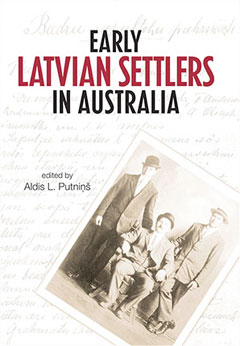
It would be fair to say that few libraries in Latvia or Australia have had their shelves overburdened by the weight of publications detailing the history of Latvians in Australia. However, this is not to say that such shelves would be bereft of books.
Significantly, the history of Latvians in Australia is much more comprehensive than Estonian or Lithuanian accounts, not to mention those of various other countries bordering the Baltic Sea. This impressive achievement can be primarily attributed to Aldis Putniņš, whose pioneering work on Latvians in Australia has appeared in a variety of books, chapters and articles over the last 30 years.
Early Latvian Settlers in Australia builds on this important body of work, revisiting many of the issues and themes raised in these earlier works and adding to them additional materials and insights that have emerged as a result of enhanced access to archival materials in both Australia and Latvia.
Examining the stories of Latvians who arrived in Australia prior to the Second World War poses a number of significant challenges. Who is Latvian? The issue is reflected in the title’s reference to Latvian settlers rather than Latvians. As John Bunke (listed as “Dutch American” and “Russian Finn”), Francis Dyson (“British”), and Fritz Zeeman (“Latvian / Russian / German?”) in Chapter 3’s list of Latvia-born Anzacs (soldiers in the Australian armed forces in the First World War) demonstrate, a Latvian birthplace does not necessarily mean that one is an ethnic Latvian.
Of course, this issue of identification is further complicated by the fact that some of these settlers did not want to be identified and consistently altered their names to avoid detection from the authorities—and subsequently historians. Putniņš additionally notes the impact of Russification, Anglicisation and Latvianisation upon the spelling of their names.
The size and nature of this migration flow from Latvia to Australia poses a second challenge. Putniņš suggests that there were 800 Latvian settlers in Australia prior to the Second World War (an estimate that is curiously unsubstantiated). Even if we take this inflated figure, it is clear that this is a very, very small group of migrants. The contributors should therefore be commended for finding these proverbial needles in the haystack. As a tiny group dispersed across Australia, these Latvian settlers were a motley collection of individuals whose personal stories and experiences did not always intersect with other Latvians. To this end, Elena Govor’s contributions stand out for identifying the unique ways in which these individual stories both intersected and diverged.
Unfortunately, the collection as a whole does not really meet the challenge of striking a balance between the individual and the larger story. This shortcoming is already evident in the introduction, where we are given a sketchy and rather descriptive background setting that makes greater reference to fleeting relations between Latvia and Australia rather than an account of the cultural, social, political and economic conditions that underpinned the accounts featured in the collection.
While Līga Lapa details the background situation in 1905 Latvia, readers unfamiliar with Australian (or British) history have little to guide them. An outline of Australia’s changing political and economic landscape (particularly in relation to migration issues) during the period under investigation would have provided some context for the reader encountering Australia for the first time. Moreover, it would have enriched some of the issues raised in Ineta Didrihsone-Tomaševksa’s look at Latvian consuls and Viesturs Karnups’s study of economic and trade relations between Latvia and Australia.
Such issues are exacerbated by the collection’s peculiar structure. While chapters appear to have been ordered to move from the individual to the “community,” the lack of chronology is jarring. The 1905 Revolution, for example, is correctly identified as a “backdrop to a number of chapters in this volume,” yet strangely the chapters devoted to this issue only appear towards the end of the collection.
A conclusion bringing together the different issues and themes raised in the different pieces and highlighting their significance would have also ironed out some of these problems. Having published so much on the area, it is disappointing that Putniņš has not attempted to make a more substantial statement on the topic and its relevance to Latvian and Australian historians working in this area, not to mention the lessons that contemporary Latvian communities (in Australia and elsewhere) can take from these stories.
Nevertheless, each of the authors in this collection has made an important and enlightening contribution to the history of migration in Latvia and Australia. By bringing these fascinating pieces together, Putniņš has not only provided a timely update to his previous studies, he also ensured that the stories of these pioneering settlers in a distant land are more accessible than ever before.
Details
Early Latvian Settlers in Australia
Aldis Putniņš, ed.
South Yarra, Victoria: Sterling Star, 2010
ISBN 9780646546803



